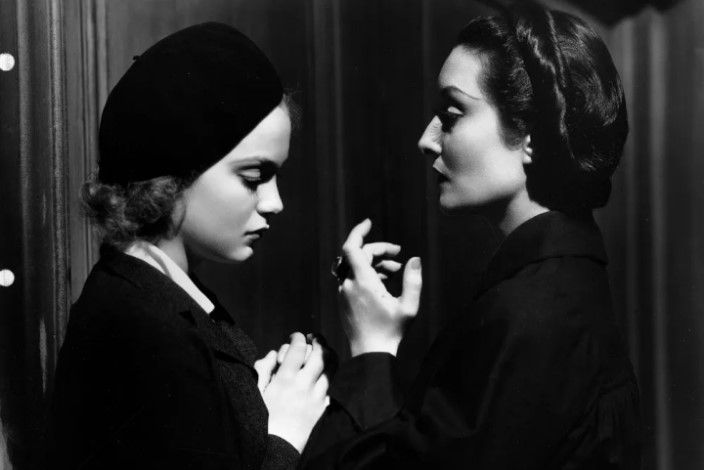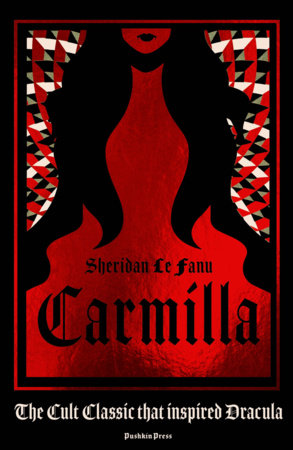
It has come to my attention that some people genuinely believe that Netflix’s new series First Kill – a teen romance about a vampire and a vampire hunter who fall in love – is the first ever piece of media about lesbian vampires – or, perhaps worse, the first one that matters. I find this deeply tragic, especially considering that this year we are celebrating the 150th anniversary of the prototypical lesbian vampire herself, Carmilla.
Once I recovered from my initial agony, I decided to turn this into a teachable moment. Why not take the opportunity to spread the lesbian vampire gospel, shed some light on a history that goes far beyond anything you’ll find on Netflix, and hopefully bring some new fans into the fold?
What follows is not an exhaustive history of the lesbian vampire trope, or even an exhaustive history of its presence in film. It’s a very long story; the trope’s cinematic history alone goes back over 85 years. This is merely a starting point: a list of some of the most essential lesbian vampire films, chosen for their importance to the trope’s history, popularization, and evolution. I’ve broken down the list into three parts: this first part will explore some of the earliest entries to the canon, the second will delve into the lesbian vampire boom of the 1970s, and the final part will cover more recent films. My goal is that by the end of this series, you’ll have a solid basic understanding of the lesbian vampire’s history – and hopefully a thirst for more.
The lesbian vampire is an exciting, erotic, and empowering character. She is a sexual transgressor who flagrantly defies social norms; she may rarely get away with it within her own narrative, but the fact that she lives on in the hearts and imaginations of so many of us proves that the powers that seek to destroy her are never truly successful. She is attractive because of her dangerous sexuality, her supernatural prowess, and her freedom from the limitations of a mortal, socially acceptable existence. She is one of the most important figures in queer horror history, and to many of us, an essential part of our personal queer journey.
I can’t imagine this is the legacy Joseph Sheridan Le Fanu had in mind when he created Carmilla back in the 19th Century. Though plenty of queer-coded literary vampires predate Le Fanu’s work, his novella birthed the prototype of the lesbian vampire as we know her today. First published as a serial, then in its entirety in Le Fanu’s short story collection In a Glass Darkly (1872), Carmilla is the most cited source text for lesbian vampire cinema, being adapted for the screen as recently as 2019.
Carmilla is about Laura, who leads an isolated and uneventful life in the Styrian countryside, with only her father and a couple of maids for company, until the night a carriage crashes outside her home and the mysterious Carmilla is left in her father’s charge. Carmilla awakens all sorts of things in Laura, and the two of them spend lots of time together gazing at each other until some men come along and ruin everything. (This happens a lot in lesbian vampire stories, but we can ignore and reject it, because vampires never really die. Just ask Dracula.)
Carl Dreyer’s VAMPYR (1932) is often cited as the first cinematic adaptation of Carmilla, as Dreyer was said to be inspired by In a Glass Darkly. Though a remarkable work of Surrealist horror, VAMPYR is light on (though not entirely without) queer eroticism. The first true modernization of Carmilla wouldn’t come until 1960, but the first lesbian vampire graced the silver screen long before that.
Which brings us to the main event: here are four of the earliest examples of lesbian vampire cinema, films that built upon the literary groundwork and set the stage for what was to come.
*****

DRACULA’S DAUGHTER (1936)
Five years after Universal’s OG monster movie, DRACULA (1931), came its first sequel, DRACULA’S DAUGHTER, starring Gloria Holden as Countess Marya Zaleska, a worthy though underappreciated successor to Bela Lugosi’s Count. The film was not commercially successful, which has left it overshadowed by the studio’s more popular output. However, DRACULA’S DAUGHTER deserves much more credit than it gets, both as a solid film and as an early progenitor of the tormented vampire longing for their lost humanity and seeking a cure for their unnatural condition.
Countess Zaleska attaches herself to Dr. Jeffery Garth, a psychiatrist whose work in the treatment of addiction she hopes will help her overcome her lust for blood. Garth tells her to confront her cravings, to face the thing she desires and challenge herself to resist, so Zaleska picks up a pretty young lady and brings her to her studio. When her will doesn’t hold up, Zaleska decides the only way she can overcome her nature is to have Garth with her forever. So, in short, a closeted lesbian struggling to quell her queer desire fixates on a man, because of course being with him will cure her of said desire. I mean, we’ve all been there, right?
The newly founded Production Code Administration also thought DRACULA’S DAUGHTER was pretty gay and demanded several revisions to the script to remove any allusions to Zaleska’s “perverse sexual desire,” particularly in her scene with Lili, the model she brings to her studio. The scene as filmed – along with a later scene of Zaleska hovering hungrily over Garth’s comatose secretary Janet – is still brimming with sexual tension and unspoken longing.
Like all classic movie monsters, Zaleska meets a grim fate, but the power of her haunting presence lives on beyond the final frame. As the godmother of all cinematic lesbian vampires, she casts a long shadow that still looms large today.

BLOOD AND ROSES (1960)
The 1940s and 1950s were woefully bereft of lesbian vampires, as horror moved away from vampires and other Gothic motifs toward more real-world terrors. But by the early ’60s, a Gothic revival was in full swing, especially in the UK and Europe – as a result, most lesbian vampire films are European. There was no better time for Carmilla to make her true cinematic debut, which she did in Roger Vadim’s dreamy BLOOD AND ROSES.
Vadim’s film moves Carmilla’s story from 19th Century Styria to contemporary Italy, where she and her cousin Leopoldo are the last of the ancient aristocratic family of Karnstein, a name synonymous with vampirism even in the 20th Century. Carmilla is in love with Leopoldo – and with his fiancée, Georgia. It’s hard to tell for whom she has stronger feelings, but her obsession with them both grows after a fireworks display unearths the tomb of her infamous ancestor, Millarca. Whether Carmilla becomes a literal vampire or is possessed by Millarca or is simply consumed by her jealousy and obsession is unclear, but the specifics don’t matter. This is a film about emotion, and we follow Carmilla’s emotional turmoil to its tragic conclusion.
Many lesbian vampire tales tend to favor neat endings where the vampire is destroyed, her victim is delivered safely back into the arms of a father or (male) lover, and order is restored. But this narrative convention has been subverted almost as often as it has been reinforced, and BLOOD AND ROSES is one of the earliest to offer a more ambiguous finale. On the surface, Leopoldo and Georgia are happily married, safe without Carmilla to threaten their union. But Carmilla (Millarca?) has left an indelible mark on the couple – and the Karnstein legacy lives on.

CRYPT OF THE VAMPIRE (1964)
Another, somewhat more faithful, Carmilla adaptation, CRYPT OF THE VAMPIRE is full of the atmosphere, melodrama, and sensuality popular in Italian Gothic horror of the 1960s. This version of the story shifts the focus back to Laura, who, like Carmilla of BLOOD AND ROSES, lives in the shadow of a vengeful ancestress. But while Carmilla and her Karnstein clan are lively socialites, Laura leads a lonely existence in an isolated family estate with her father and a handful of servants, cut off from the rest of the world.
That is, of course, until a fateful carriage accident drops a beautiful young lady named Ljuba into her lap. Laura is immediately smitten, and the two spend the next several days frolicking in the gardens, gazing into each other’s eyes, and generally being super gay. For a while, Ljuba seems to dispel the shadows that hung so heavily over Laura’s life, so much so that Laura’s father begins to wonder if the curse of their ancestor was just a legend after all. But as is always the case in these movies, a legend is never just a legend.
As a low budget film that was never widely released (it went straight to television in the US) and has only very recently received a decent restoration, CRYPT OF THE VAMPIRE is often tragically overlooked. But it earns its spot on this list by being the first to closely imitate critical aspects of Le Fanu’s narrative (Laura’s emotional and physical isolation, the carriage crash and mysterious mother, etc.), and it retains the novella’s most essential theme: Carmilla (or her stand-in, Ljuba) as the catalyst for Laura’s sexual awakening. All these things would be adapted more famously later, overshadowing CRYPT OF THE VAMPIRE and resulting in its relative obscurity, but the film deserves due credit as an important part of Carmilla’s long history.

EMOTION (1966)
Though lesbian vampires are predominantly a European phenomenon, they have a global appeal. Japanese filmmaker Nobuhiko Obayashi – who would later achieve cult status for his pièce de résistance, HOUSE (1977) – made his experimental short film EMOTION in homage to Roger Vadim’s BLOOD AND ROSES. EMOTION is something of an anomaly in a subgenre that remains overwhelmingly white and Western, which heightens the film’s importance to a fundamental understanding of the lesbian vampire’s cultural impact.
The heart of EMOTION is Emi, who leaves the sleepy seaside village of her youth for the excitement of the big city. There she meets Sari; the two become inseparable until a man comes along who falls in love with Emi and replaces Sari in her heart. The joy she once shared with Sari she now shares with him, and Sari is left alone, wandering in the fields where she and Emi were once happy. This guy might also be a vampire. And Emi also has a fling with Sari’s mom, who is into sadomasochism. And much of what happens may or may not be a dream.
There’s a lot going on and it’s a bit disjointed, as Obayashi focuses more on emotional and visual storytelling than narrative cohesion. Simply put, EMOTION is about loss of innocence. Emi and Sari’s painful transition from the wonders of youth to the cruel realities of adulthood is laid bare by Obayashi’s exceptional sense of whimsy and an approach to horror that is playful one moment and remarkably dark the next. Though he was still finding his footing when he made the film, the unique style for which Obayashi would become internationally renowned is plainly on display. He was a one-of-a-kind filmmaker, making EMOTION a one-of-a-kind lesbian vampire film.
*****
Coming up next: a look at five essential films from the most prolific decade in lesbian vampire history — the 1970s.
Tags: Europe, France, Horror, japan, Joseph Sheridan Le Fanu, Lesbian Vampires, Lesbians, Nobuhiko Obayashi, Roger Vadim, Sex, The 1930s, The 1960s, Vampire Lesbians, vampires




No Comments